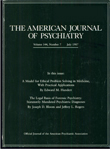Toward a biochemical classification of depressive disorders, V: Heterogeneity of unipolar depressions
Abstract
The authors found that the mean urinary level of 3-methoxy-4- hydroxyphenylglycol (MHPG) was significantly lower in 20 patients with bipolar manic-depressive or schizoaffective depressions than in either 50 patients with unipolar depressions or 26 age- and sex-matched control subjects. In contrast, the mean MHPG levels in the total group of patients with unipolar depressions and in any subgroup defined by Research Diagnostic Criteria (RDC) were not significantly different from control values. However, examination of the distribution of urinary MHPG levels in patients with unipolar depressions in relation to other recent findings by the authors' collaborative research group suggested the existence of at least three biochemical subtypes of unipolar depressions that may, in part, be differentiated on the basis of urinary MHPG levels.
Access content
To read the fulltext, please use one of the options below to sign in or purchase access.- Personal login
- Institutional Login
- Sign in via OpenAthens
- Register for access
-
Please login/register if you wish to pair your device and check access availability.
Not a subscriber?
PsychiatryOnline subscription options offer access to the DSM-5 library, books, journals, CME, and patient resources. This all-in-one virtual library provides psychiatrists and mental health professionals with key resources for diagnosis, treatment, research, and professional development.
Need more help? PsychiatryOnline Customer Service may be reached by emailing [email protected] or by calling 800-368-5777 (in the U.S.) or 703-907-7322 (outside the U.S.).



